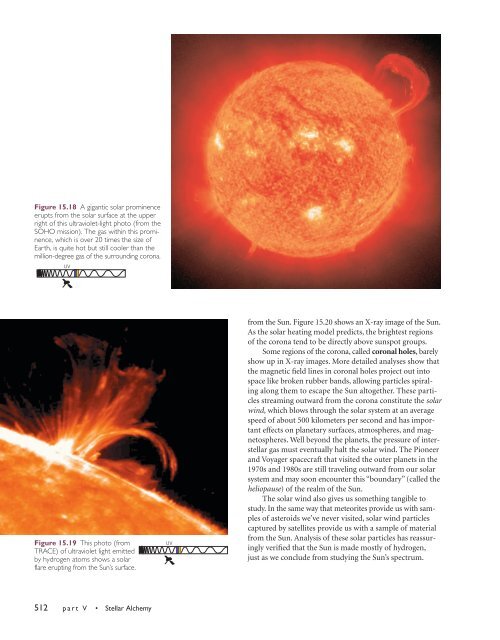Chapter 15--Our Sun - Geological Sciences
Chapter 15--Our Sun - Geological Sciences
Chapter 15--Our Sun - Geological Sciences
Create successful ePaper yourself
Turn your PDF publications into a flip-book with our unique Google optimized e-Paper software.
Figure <strong>15</strong>.18 A gigantic solar prominence<br />
erupts from the solar surface at the upper<br />
right of this ultraviolet-light photo (from the<br />
SOHO mission). The gas within this prominence,<br />
which is over 20 times the size of<br />
Earth, is quite hot but still cooler than the<br />
million-degree gas of the surrounding corona.<br />
UV<br />
Figure <strong>15</strong>.19 This photo (from<br />
TRACE) of ultraviolet light emitted<br />
by hydrogen atoms shows a solar<br />
flare erupting from the <strong>Sun</strong>’s surface.<br />
UV<br />
from the <strong>Sun</strong>. Figure <strong>15</strong>.20 shows an X-ray image of the <strong>Sun</strong>.<br />
As the solar heating model predicts, the brightest regions<br />
of the corona tend to be directly above sunspot groups.<br />
Some regions of the corona, called coronal holes, barely<br />
show up in X-ray images. More detailed analyses show that<br />
the magnetic field lines in coronal holes project out into<br />
space like broken rubber bands, allowing particles spiraling<br />
along them to escape the <strong>Sun</strong> altogether. These particles<br />
streaming outward from the corona constitute the solar<br />
wind, which blows through the solar system at an average<br />
speed of about 500 kilometers per second and has important<br />
effects on planetary surfaces, atmospheres, and magnetospheres.<br />
Well beyond the planets, the pressure of interstellar<br />
gas must eventually halt the solar wind. The Pioneer<br />
and Voyager spacecraft that visited the outer planets in the<br />
1970s and 1980s are still traveling outward from our solar<br />
system and may soon encounter this “boundary” (called the<br />
heliopause) of the realm of the <strong>Sun</strong>.<br />
The solar wind also gives us something tangible to<br />
study. In the same way that meteorites provide us with samples<br />
of asteroids we’ve never visited, solar wind particles<br />
captured by satellites provide us with a sample of material<br />
from the <strong>Sun</strong>. Analysis of these solar particles has reassuringly<br />
verified that the <strong>Sun</strong> is made mostly of hydrogen,<br />
just as we conclude from studying the <strong>Sun</strong>’s spectrum.<br />
512 part V • Stellar Alchemy
















